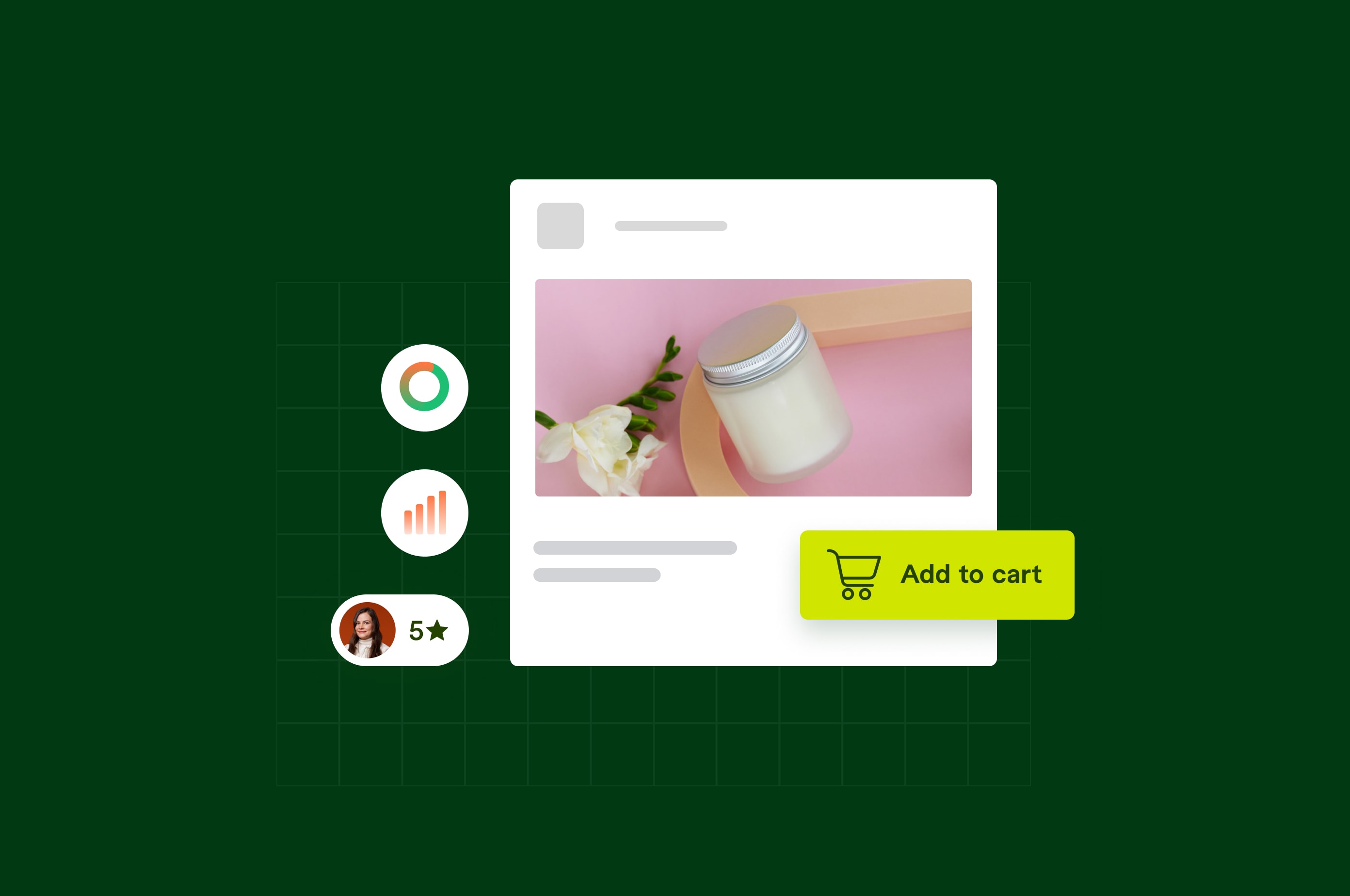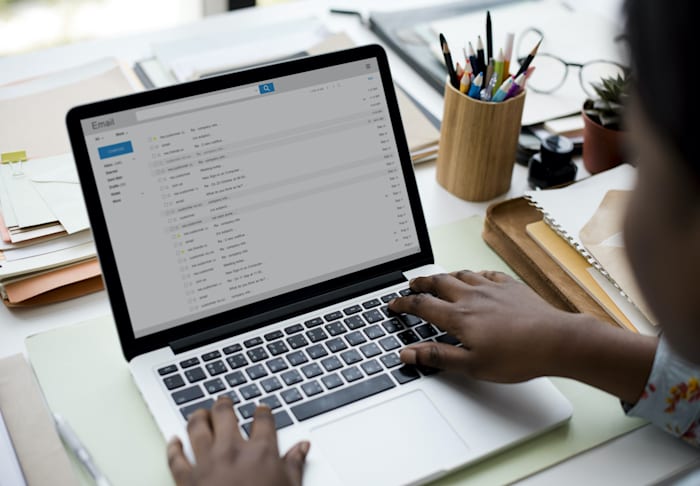How to Do Email Marketing: A Complete Guide
Unlock the power of email marketing with this guide. Learn strategy, best practices, and a step-by-step tutorial to boost your ROI and engage customers.
 September 10, 2024
September 10, 2024 8 minute reading
8 minute reading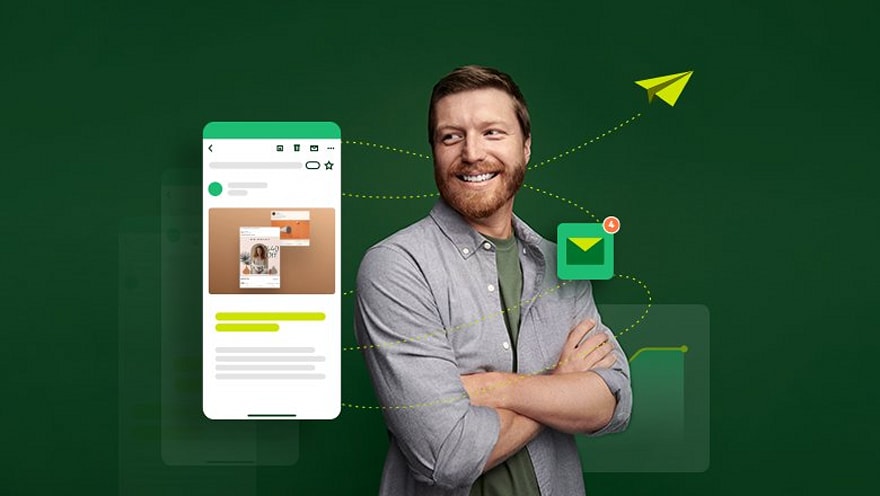
Imagine a marketing tool so powerful it generates $36 for every $1 spent. Welcome to email marketing, the hero of digital outreach.
Email remains a constant in an age of fleeting social media posts and algorithm changes. It's personal, direct, and astonishingly effective. Yet many businesses still need to tap into this goldmine. If you're one of them, you're in the right place.
In this guide, we'll walk you through planning, creating, and optimizing email campaigns that drive actual results.
Why does email marketing matter?
You might wonder if email marketing still holds up in an era dominated by flashy video campaigns and social marketing techniques. And the answer is a resounding yes.
Email marketing continues to quietly and consistently deliver results that other marketing channels struggle to match. It offers advantages like:
High return on investment (ROI): As noted above, email marketing has an ROI of 3,500%. For every dollar invested, you’re gaining 35 times your initial investment.
Widespread user base: As of 2024, there are over 4.26 billion email users worldwide, a number expected to grow to 4.73 billion by 2026. This user base provides businesses with an enormous potential audience.
High engagement rates: Email boasts an average open rate of 21.5% across industries, with some sectors like financial services (27.1%) and non-profits (26.6%) seeing even higher engagement, according to data from Campaign Monitor.
Email marketing can deliver all of these benefits for any retail or online business. However, success requires more than just sending messages. It requires a strategy tailored to your audience's needs.
How to do email marketing in eight steps
Follow these essential steps to launch and maintain a successful email marketing campaign:
Step 1: Plan your email marketing strategy
Effective email marketing begins with a solid strategy. Start by analyzing your business's internal strengths and weaknesses, as well as external opportunities and threats.
Consider factors like market trends, technological advancements, and legal requirements that could impact your campaigns.
Next, define SMART goals and objectives:
Specific: Clearly defined goals with precise desired outcomes
Measurable: Success metrics that can be tracked and quantified
Achievable: Goals within reach of the business's capabilities
Relevant: Goals align with overall business objectives
Time-bound: Goals have defined timeframes for completion
Say you're an ecommerce company; you could set a goal like Achieve a 15% increase in average purchase value by sending post-purchase upsell emails over the next year.
Understand your audience deeply, considering demographics, interests, pain points, and goals. This allows you to create targeted, effective campaigns.
Finally, create a content calendar mixing various types of emails:
Promotions
Educational content
Newsletters
Holiday campaigns
Automated emails
You can add your content to a Google Sheet or use an email marketing tool to schedule posts.
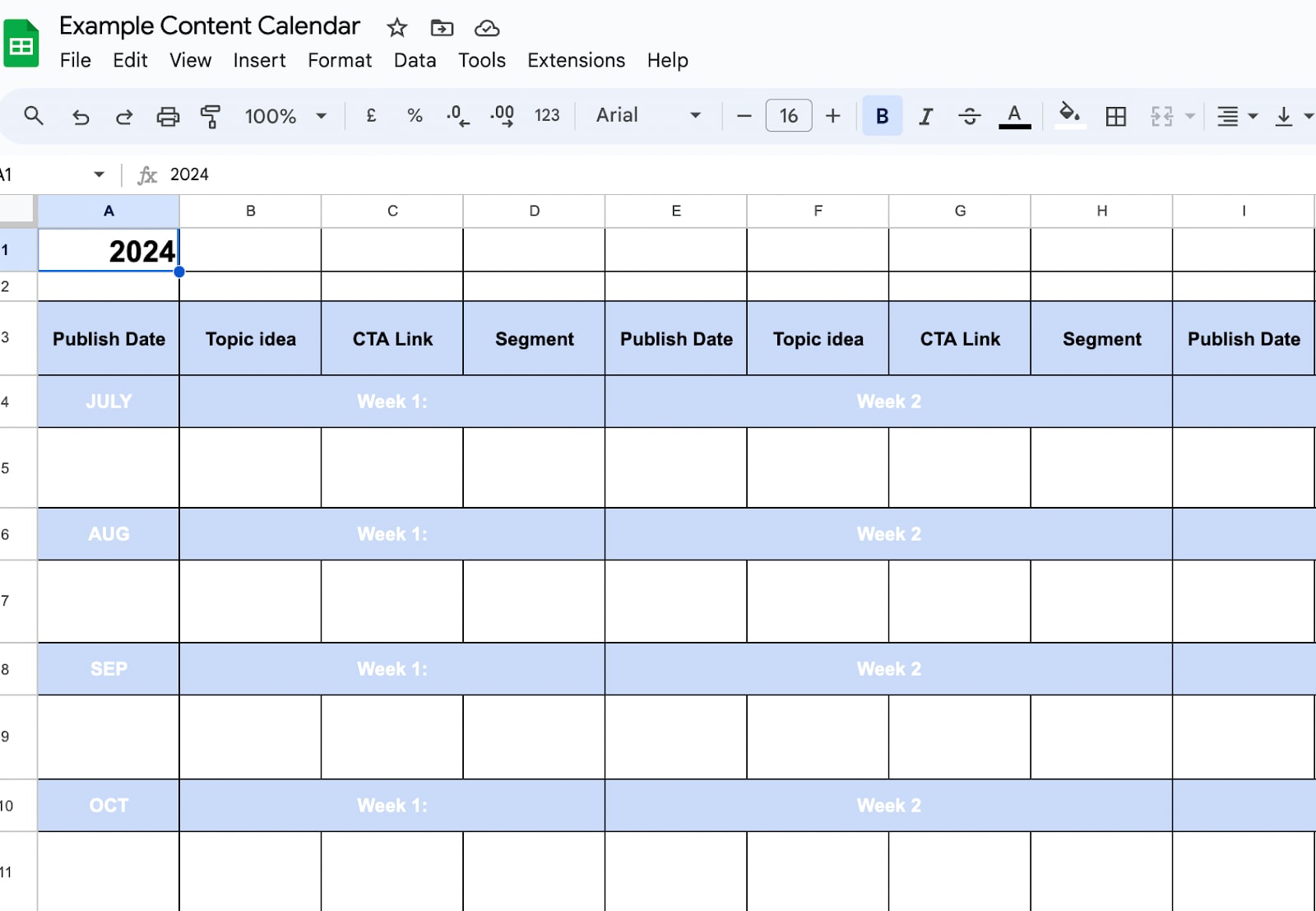
By following these steps, you'll build a structured approach to email marketing that aligns with your business goals and resonates with your audience.
Step 2: Choose the best email marketing platform
You've crafted your email marketing strategy, and now it's time to bring it to life. The next step? Finding the perfect software to execute your vision.
The world of email marketing tools is vast and varied, with each platform offering unique features. Your choice can significantly impact how effectively you reach and engage your audience.
Mailchimp
Best for beginners
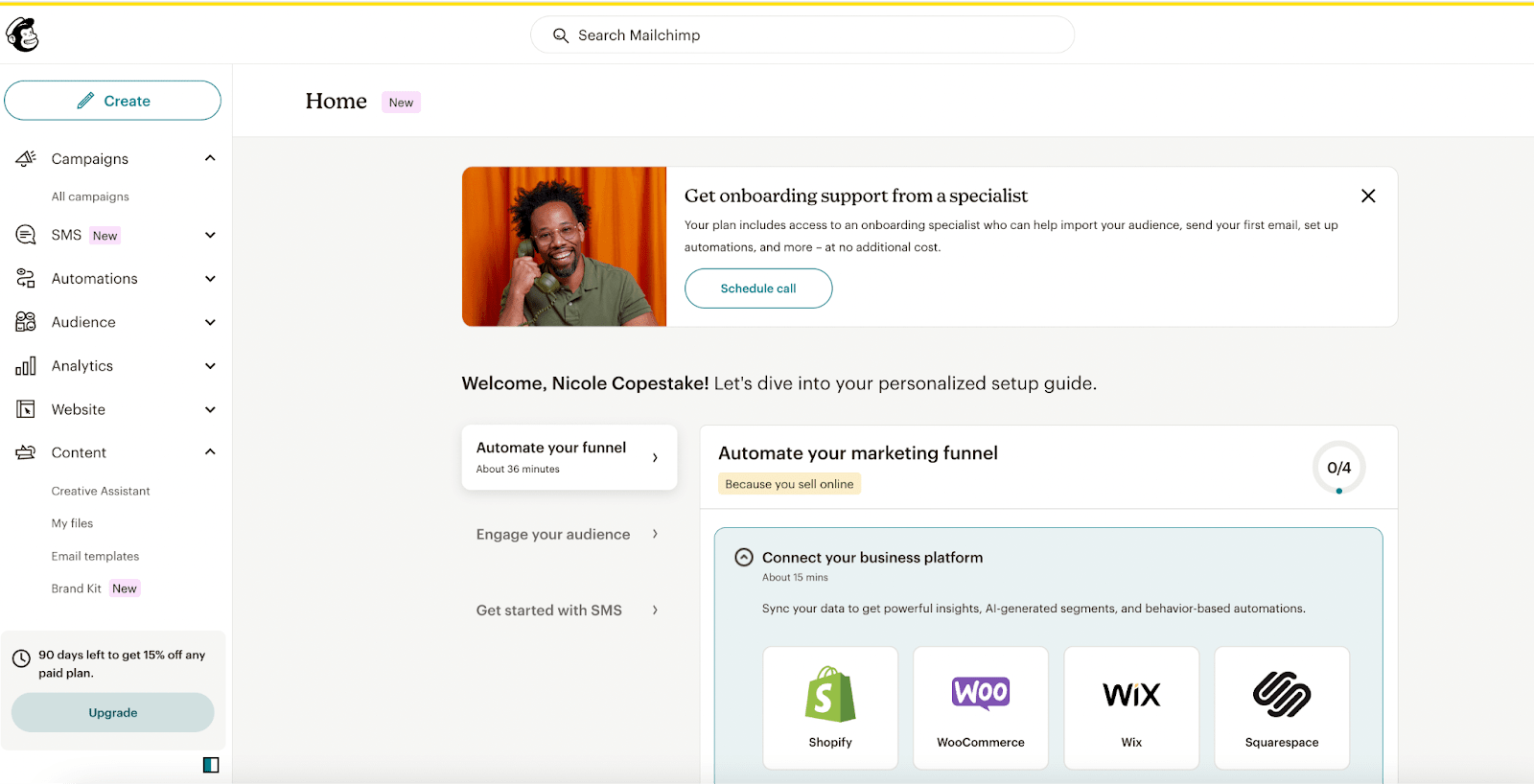
Mailchimp stands out with its user-friendly interface and generous free plan. Its intuitive drag-and-drop builder makes creating campaigns a breeze, even for those new to email marketing. Mailchimp also integrates with e-Commerce platforms like Shopify, WooCommerce, and Squarespace.
ConvertKit
Best for bloggers and content creators
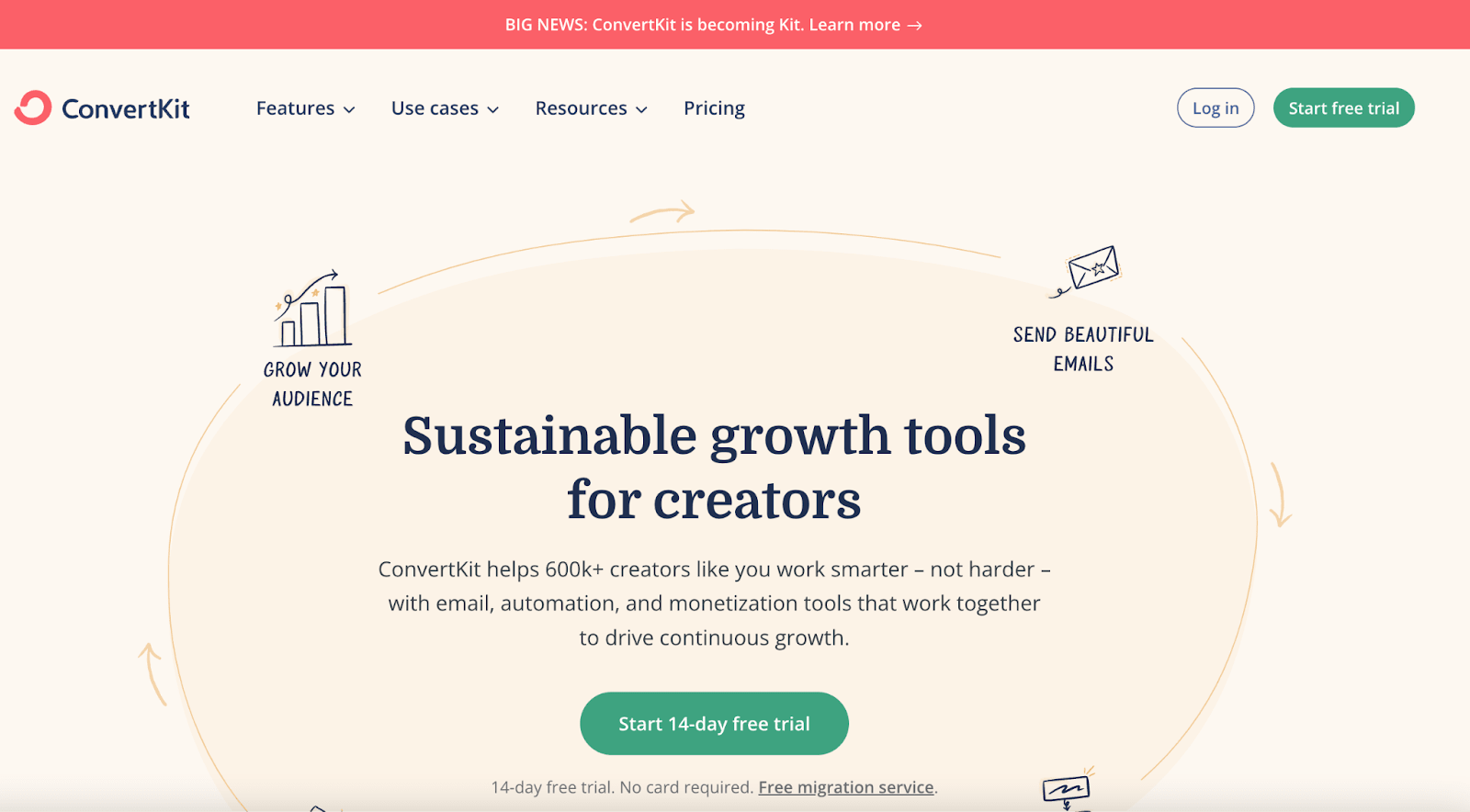
Publishers often gravitate towards ConvertKit. Its focus on list growth through lead magnets and seamless integration with platforms like Patreon makes it a favorite among digital content producers.
Klaviyo
Best for ecommerce brands

If you're in e-Commerce, Klaviyo is your best bet. Its advanced segmentation and personalization features and powerful analytics can help maximize your revenue through highly targeted campaigns.
Beehiiv
Best for email newsletter creators

The up-and-coming Beehiiv offers an attractive package for newsletter creators. With high deliverability rates and built-in monetization features, it's quickly gaining popularity among solopreneurs and small teams.
Most of these platforms offer free trials. Take advantage of these to test drive the features, explore the email templates, and find the perfect fit for your email marketing journey.
Step 3: Set up your account
Setting up your email marketing account is the next step toward successful campaigns.
Visit your chosen email service provider's website and sign up for an account that fits your needs. Once you've created your login, you'll need to verify your email address to ensure deliverability.
Next, personalize your account by:
Adding your company information and logo
Setting up your sender name and email
Customizing brand colors and fonts
Connect your account to your website and other tools like your CRM for seamless lead collection and data tracking. Get acquainted with anti-spam regulations and set up authentication protocols. Having a well-configured email account is key to effective email marketing.
Step 4: Build your email list
With your email marketing platform set up, it's time to focus on growing your audience. An email list full of contacts is important; otherwise, you'll have no one to message. Three effective tactics to build your subscriber base include:
Lead magnets
Lead magnets are free, valuable content pieces offered in exchange for a visitor's email address. They’re excellent for converting website visitors into engaged subscribers.
Popular lead magnets include:
E-books or whitepapers
Templates or checklists
Webinars or training sessions
Coupons or giveaways
Assessments or quizzes
Lead magnets should be relevant. They should solve a specific problem or fulfill a need for your target audience, motivating them to give you their email address. HubSpot, for example, offers free templates for readers to download on most of its blog content.

Referrals
Don’t underestimate the power of word-of-mouth. Studies show that referred customers are more loyal and create larger profit margins than other customers.
Encourage subscribers to refer friends through these strategies:
Offer referral incentives (e.g., discounts or exclusive content)
Spotlight influencers who use your product or service
Build ambassador programs for your most engaged subscribers
Highlight social proof with testimonials or subscriber counts
Send targeted referral requests to your most active subscribers

Getting referrals can help you build your email list faster.
The following email from Podcaser Pulse uses Beehiiv's referrals tool to boost subscribers and improve list-building efforts.
Focus on building a list of engaged subscribers who genuinely want to hear from you. By combining compelling lead magnets, smart referral strategies, and optimized opt-in forms, you'll be well on your way to email marketing success.
Step 5: Create compelling email content
The content in your email drives conversions. It starts with your subject line, which encourages readers to click.
Use attention-grabbing headlines that pique readers' interest and help your email stand out in crowded inboxes. Consider using emojis or numbers to catch the eye.
Variety is key to keeping subscribers engaged. Mix up your content with:
Promotional emails with deals and new arrivals
Educational content sharing industry insights and tips
Newsletters with curated or original content
Automated post-purchase or win-back sequences
Tailor each type to your campaign goals for maximum impact. If writing isn't your forte, consider hiring an email copywriter or leveraging AI writing tools to create exciting content.
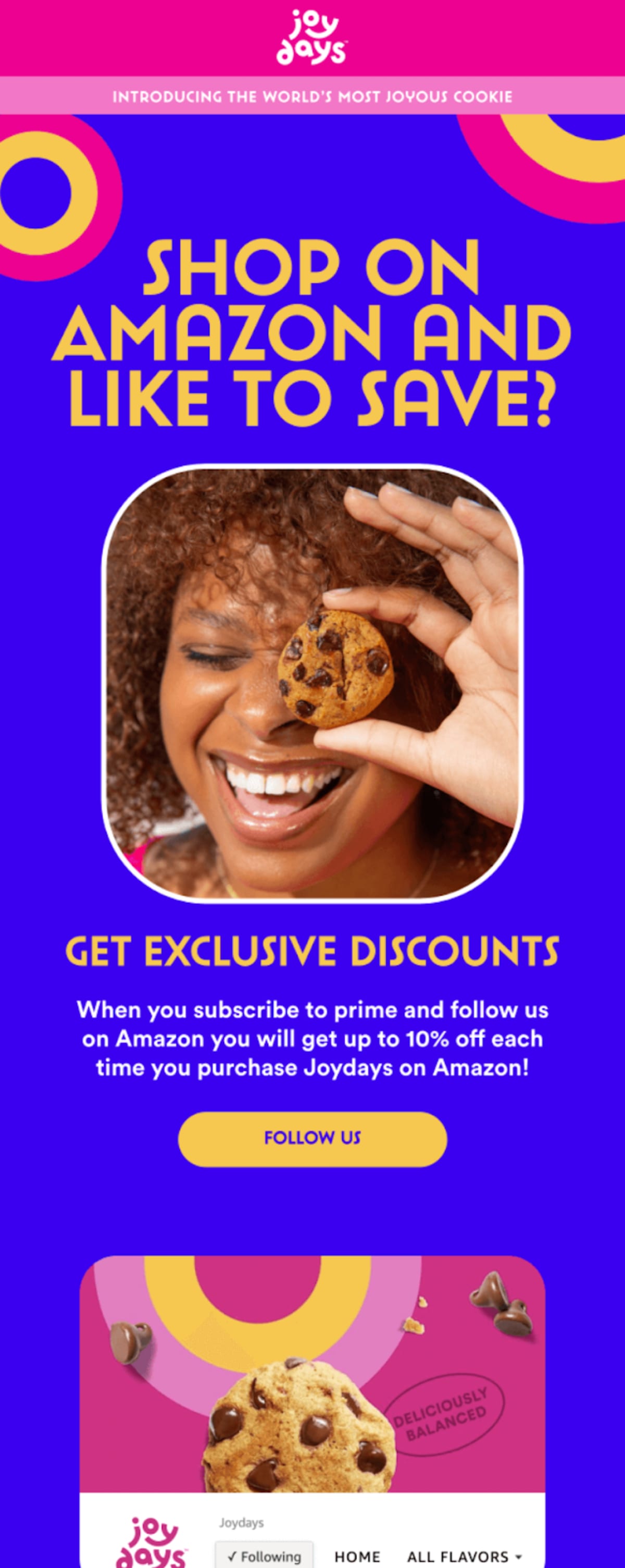
Eye-catching images, GIFs, and videos can increase clicks and conversions.
A great email example comes from Joydays. The email has striking colors and images, with an offer that excites readers (who doesn’t love to save money?)
(Image source: Really Good Emails)
💡 Tip: Hiring an email designer from Fiverr is a cost-effective way to make your email campaigns more visually compelling and performant. A skilled designer can go beyond Canva to create customized templates, attractive layouts, engaging graphics, and animated gifs that captivate your subscribers.
Step 6: Segment your audience
Creating segments for your email list is a powerful way to increase engagement and conversions. Instead of waiting to implement this after building your list, start early.
Effective segmentation can be based on various factors:
Demographics: Tailor content by age, location, gender, or job title. For instance, send college students entry-level job advice or promote local events to city-specific subscribers.
Behaviors: Analyze email interactions, website visits, and purchase history. Use this business data to send re-engagement emails to inactive subscribers or recommend products based on recent purchases.
Engagement levels: Prioritize highly engaged subscribers with special incentives, while attempting to win back inactive ones with personalized offers.
It's easy to fine-tune campaign relevance and improve performance if you combine these segmentation methods.
Keep subscriber preferences in mind, balance promotional content with valuable resources, and monitor key metrics to avoid list burnout. With this approach, you don't just reach inboxes, you build lasting relationships.
Step 7: Automate your email campaigns
Automation is the secret weapon of all digital marketing activities. Setting up smart campaigns will save time and ensure consistent communication with your subscribers.
Imagine greeting new subscribers with personalized welcome emails, introducing your brand, and sharing valuable content over their first week. This builds immediate trust and engagement.
But automation doesn't stop there. Consider these strategies:
Post-purchase follow-ups: From order confirmations to review requests, keep customers informed, and encourage repeat business.
Abandoned cart reminders: Recapture lost sales with timely, persuasive messages.
Aura Bora's abandoned cart email sparkles with personality, just like their whimsical sparkling water flavors.
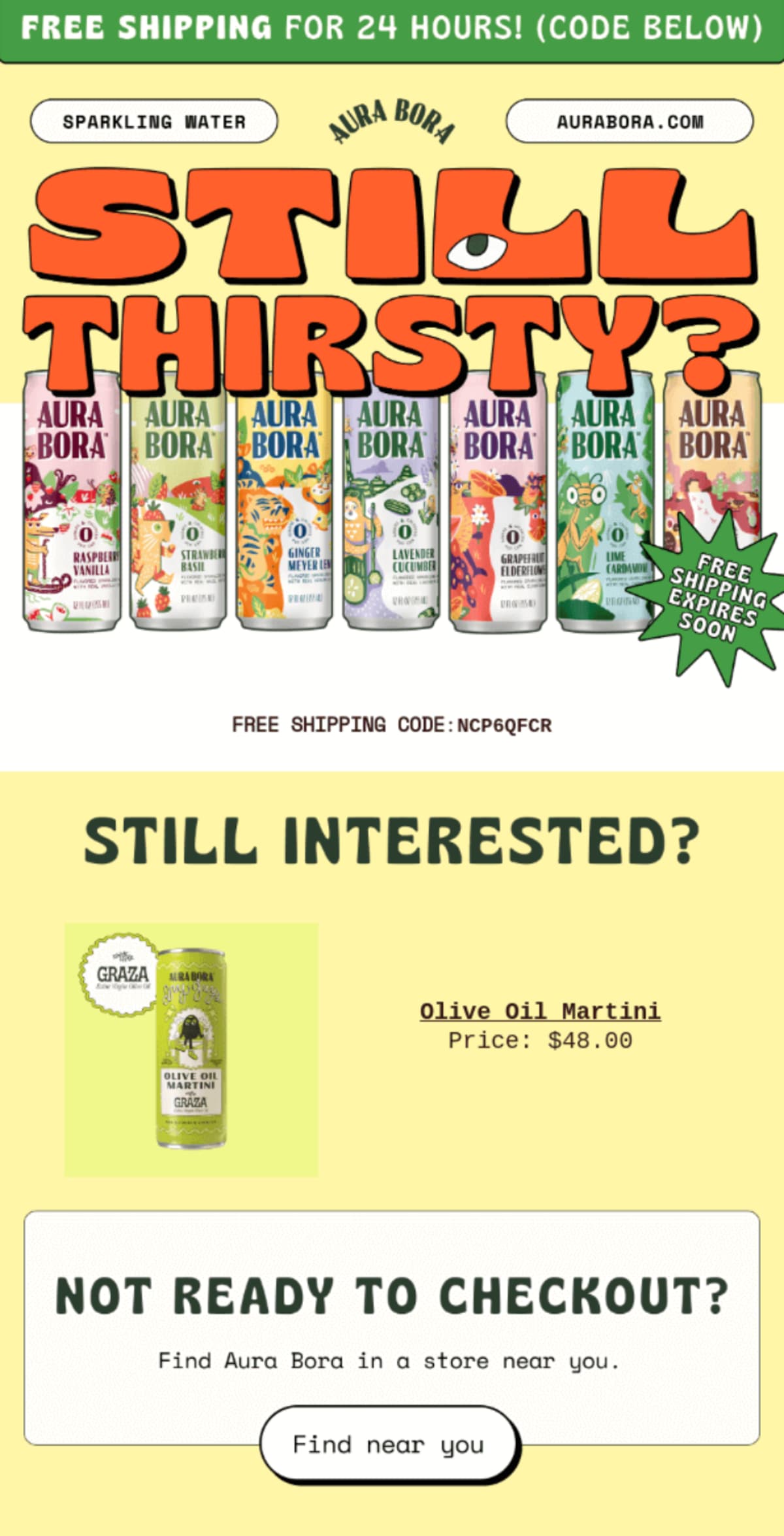
Aura Bora's abandoned cart email sparkles with personality, just like their whimsical sparkling water flavors.
(Image source: Really Good Emails)
From the cheeky "STILL THIRSTY?" headline to the eye-catching array of botanical-inspired cans, this reminder quenches your curiosity while tempting your taste buds with a limited-time free shipping offer. It's a refreshing approach that makes you want to dive right in and complete your purchase.
The beauty of marketing automation lies in its ability to nurture relationships at scale. Whether you're onboarding new contacts, providing excellent customer service, or recovering potential lost sales, automated campaigns work tirelessly in the background.
Step 8: Analyze email performance
Much of your email marketing success lies in the numbers. Regularly analyzing campaign metrics can take your strategy from guesswork to precision.
Track essential metrics:
Open rates: Percentage of recipients who opened your campaign
Click-through rates: Percentage who clicked links after opening
Conversion rates: Percentage who completed your desired action
These numbers tell a story about your audience's engagement and preferences. But don't stop at mere observation. Use these insights to optimize your campaigns. Is a particular subject line underperforming? Are certain segments losing interest?
This is where A/B testing comes in. It involves creating two versions of an email with a single variable changed, then sending each version to a small subset of your audience to see which performs better.
Test variations in:
Subject line phrasing, length, and emojis
Content formatting and length
Send times and frequency
The data can guide you to email marketing excellence, transforming your campaigns into engaging, high-converting messages that resonate with your audience.
6 email marketing tips
How can you ensure your messages resonate with inboxes that are more crowded than ever? Here are six best practices to follow to make your emails memorable.
Personalize where you can
Gone are the days of "Dear Valued Customer." Today's savvy consumers expect emails that speak directly to them. Truly effective campaigns craft content that feels tailor-made for each recipient.
Imagine opening an email from your favorite clothing store. Instead of a generic promotion, you're greeted with outfit suggestions based on your past purchases, in your size, and suited to your local weather. That's the power of personalization.
Dive deep into your customer data. Use purchase history, browsing behavior, and demographic information to segment your list and create targeted campaigns. Your goal? Make each subscriber feel like you're writing exclusively for them.
Write catchy subject lines
Your subject line determines whether your message gets opened or not.
Consider this example: "Your Summer Wardrobe Awaits! 24-Hour Flash Sale Inside ⏰". This subject line creates urgency, promises value, and uses an emoji to catch the eye. It's short, sweet, and hard to ignore.
When writing subject lines, channel your inner journalist. What's the hook? Why should the reader care? Aim for concise phrasing that creates curiosity, and always deliver on your promise within the email.
Optimize for mobile devices
If your email doesn't shine on that small screen, it might as well be invisible. Incorporate large, tappable buttons for your calls-to-action (CTAs). Keep your copy concise and your design clean.
Before hitting send, test your emails on various devices. What looks perfect on your desktop might become a jumbled mess on an iPhone. Don't let poor mobile design sabotage your brilliant campaign.
Make every email count
Every email you send should answer one crucial question for the recipient: "What's in it for me?" Offer value in every message, whether through exclusive discounts, insider tips, or entertaining content.
Strive for a balance between promotional content and valuable information. The 80/20 rule is a good guideline: 80% helpful content and 20% promotional. This positions you as not just another brand pushing sales but a valuable resource for email subscribers.
Have clear CTAs
Every great email has a purpose, and your call-to-action fulfills that purpose. Whether you want readers to make a purchase, read a blog post, or sign up for a webinar, your CTA should stand out.
When crafting your CTA, opt for action-oriented language, make it visually distinct, and ensure relevance to the email's content. Avoid overwhelming your reader with too many options. One main CTA per email often proves most effective.
Make it easy to unsubscribe
Making unsubscribing easy isn't just good practice—it's the law. Email regulations like CAN-SPAM and GDPR mandate clear, simple opt-out processes.
Place your unsubscribe link prominently in every email, typically in the footer. It requires at most one or two clicks to complete the process. Avoid using small fonts or hiding the link.
A straightforward unsubscribe option is better than recipients marking your emails as spam, which can harm your sender reputation.
Start driving sales with email marketing
Email marketing is still powerful for engaging customers and converting them. You can create targeted and high-performing emails by following the tips in this guide.
Hire Fiverr email marketing experts to make your campaigns even better. From list segmentation to analytics, these pros can optimize your efforts, ensuring you get subscribers and reach your business goals.
Email marketing FAQ
Is email marketing still profitable?
Email marketing remains profitable for many businesses. According to multiple studies, the average ROI is anywhere between $36 and $40 for every dollar spent. Its success depends on factors like audience targeting, content quality, and adherence to regulations.
Can I make money sending emails?
Making money by sending emails is possible through methods like affiliate marketing or promoting your own products/services. However, it requires building a quality email list and providing value to subscribers to be successful and avoid being marked as spam.
How can I do good email marketing?
A good email marketing strategy involves providing valuable, relevant content to segmented audiences and optimizing based on performance. It's also important to follow best practices, such as mobile optimization and personalization, and comply with laws and regulations
How do I work in email marketing?
Develop skills like copywriting, HTML, data analysis, and email marketing platforms to work in email marketing. Put yourself in the best position for email marketing roles by doing internships or freelance work, building a portfolio, and staying on top of industry trends.
